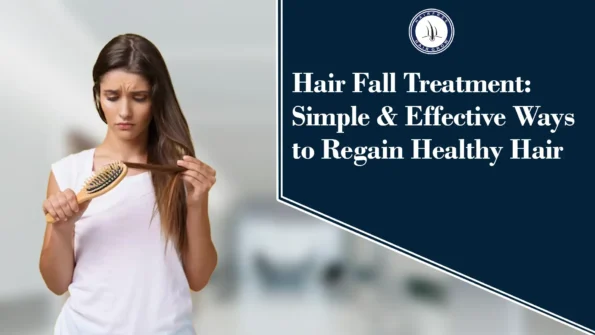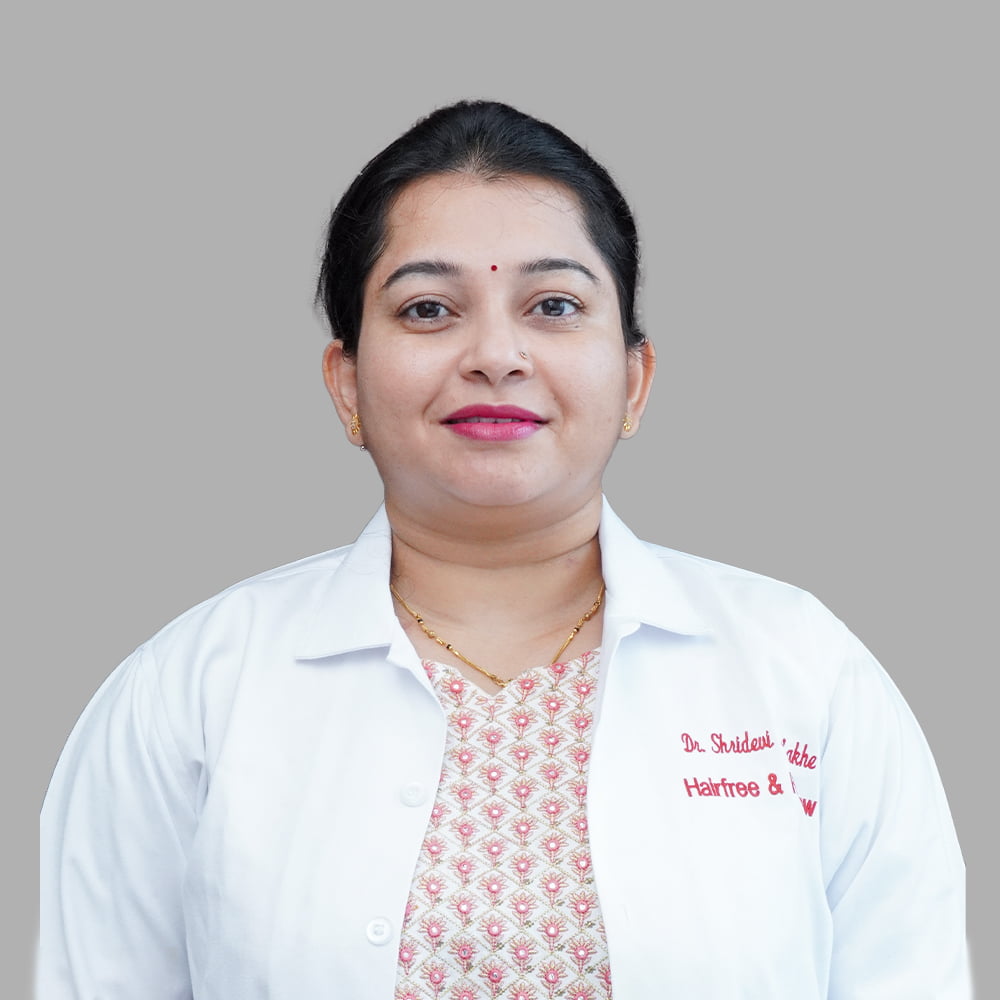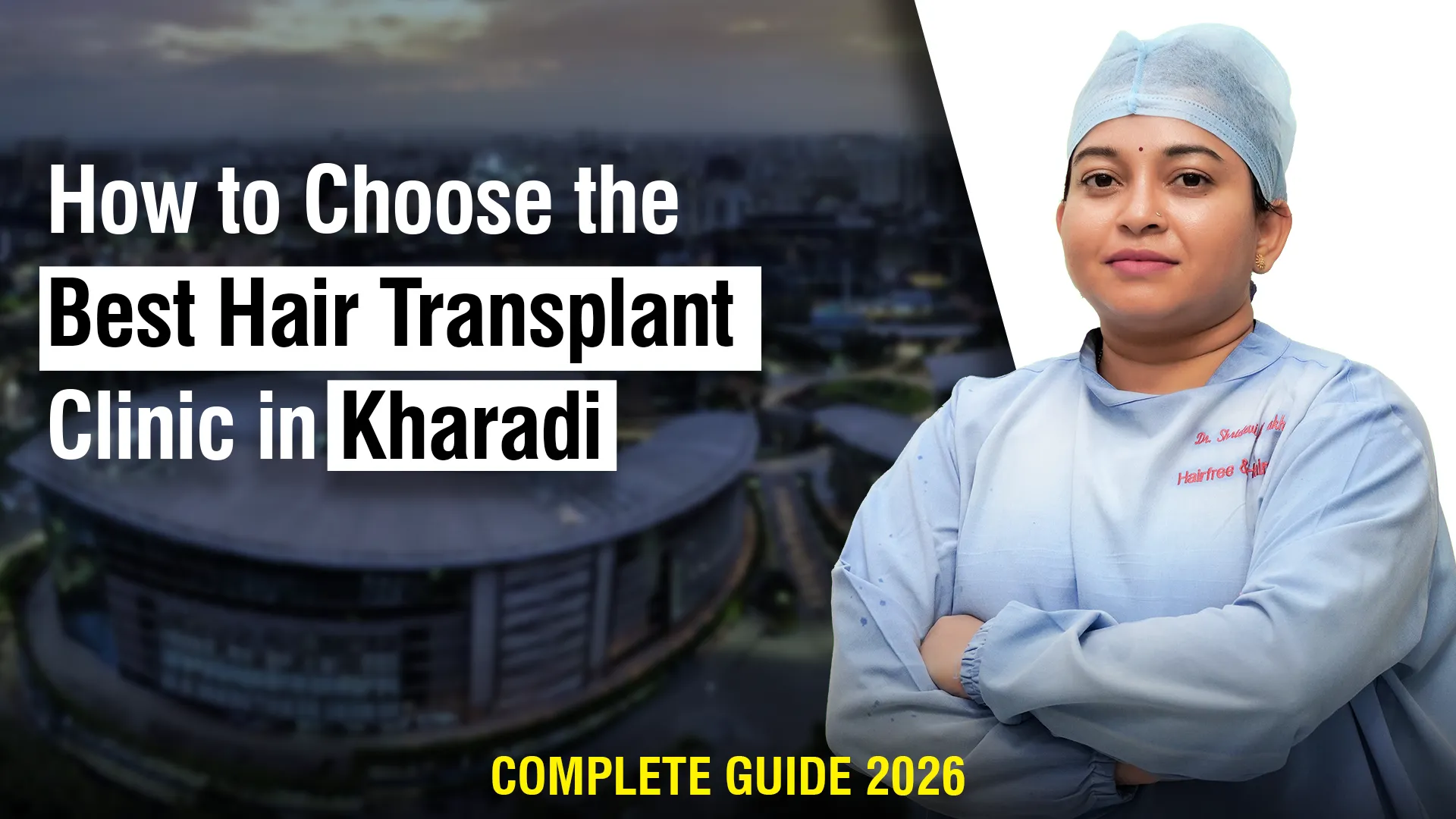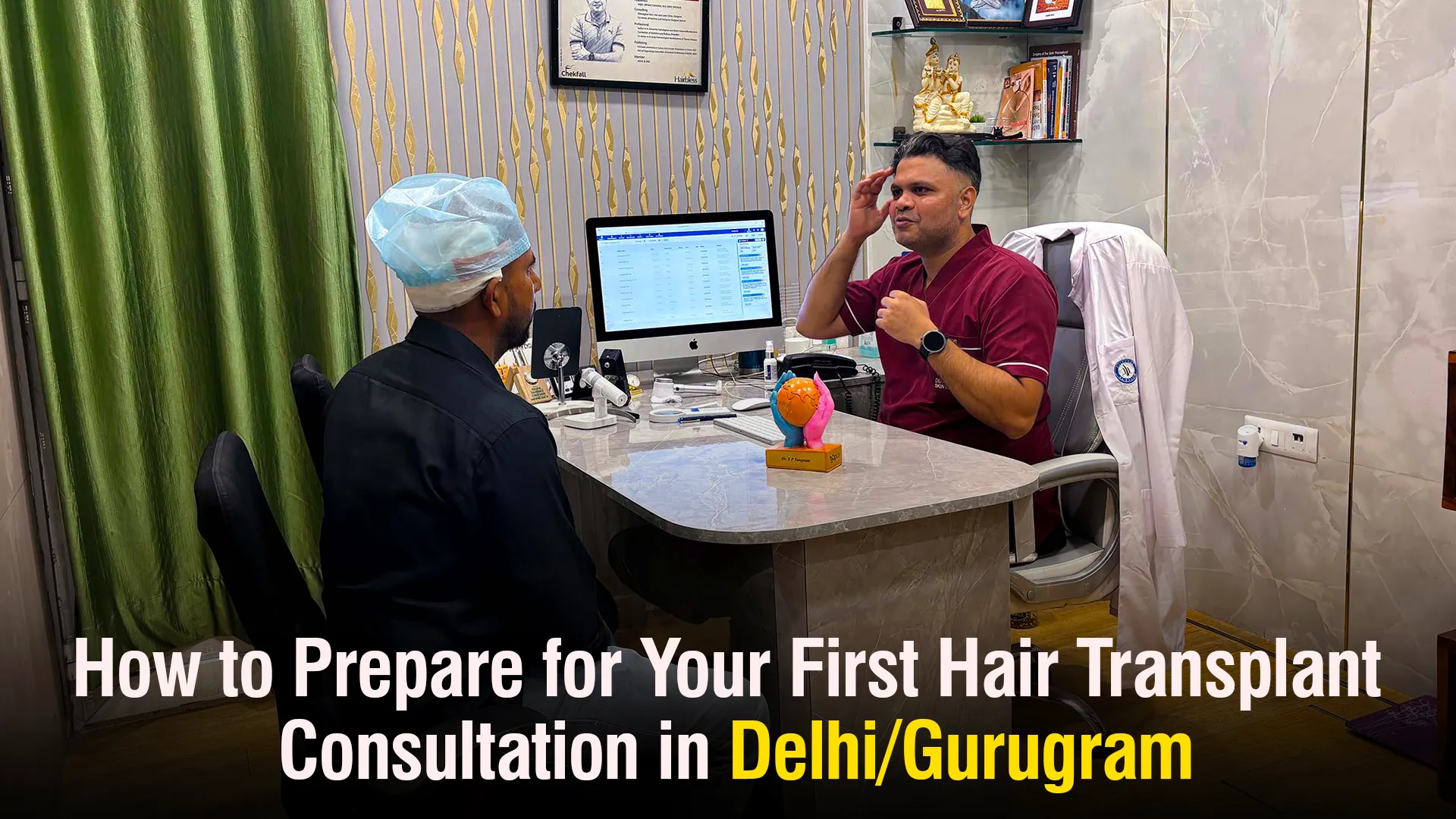Dealing with hair fall can be frustrating and, at times, discouraging. Whether you’re noticing more strands in your comb or feeling self-conscious about thinning hair, you’re not alone. Hair fall is a concern for many, but the good news is that there are ways to tackle it.
From natural remedies to advanced treatments, there are several options available to help you regain thicker, healthier hair.
In this blog, we’ll dive into various hair fall treatments that can make a real difference, offering you practical solutions that fit your lifestyle. Let’s explore how you can take control of your hair’s health and boost your confidence!
What’s Normal with Hair?
First, let’s talk about what’s normal when it comes to hair.
We have around 100,000 to 150,000 hair follicles on our scalp. These follicles are set at birth—we can’t grow new ones. Losing 100 to 150 hairs per day is completely normal. But if you start shedding 300 to 700 hairs daily, that’s a sign of excessive hair loss.
Of course, you don’t have to count each strand on the floor! Instead, check your hairbrush, pillow, or shower drain. If you notice more hair than usual, it might be time to look into a hair loss treatment.
Hair Thinning with Age
As we age, it’s completely normal to experience thinner hair. If you’re 65 and have less hair than when you were 18, don’t worry—it’s just part of the natural aging process. While treatments can help you grow more hair, they can’t completely restore the volume of your teenage years.
Hair loss also becomes noticeable only when about 50% of your hair is gone. So by the time others start seeing it, you’ve likely lost quite a bit.
The Most Common Cause: Androgenetic Alopecia
The most common type of hair loss is androgenetic alopecia. This is known as male pattern baldness in men and female pattern baldness in women.
This happens due to hormonal influences, specifically androgens (male hormones). In men, dihydrotestosterone (DHT) is the main culprit, while in women, other male hormones contribute to hair thinning.
What Can You Do?
If you’re struggling with hair thinning, don’t worry—there are solutions! Consulting a dermatologist for hair loss is the best step to find the right hair fall treatment for you. They can recommend medications, lifestyle changes, and advanced treatments to slow down hair loss and even promote regrowth.
Can Stress Cause Hair Loss?
Yes, stress can lead to hair loss. In fact, many people started experiencing hair loss due to stress after COVID-19. Earlier, only a few people noticed this link, but now it’s widely recognized.
How Does Stress Affect Your Hair?
Both mental and physical stress can trigger hair loss. When you’re stressed, your body releases hormones like cortisol, which can affect hair growth. These hormones interfere with the natural cycle of hair growth, leading to losing hair from stress after a few months.
It doesn’t happen overnight. If you go through a stressful event, your hair may start falling out 2 to 6 months later. This is common after events like childbirth, surgery, illness, or emotional distress. The most common type of stress-related hair loss is called telogen effluvium, where a large number of hair strands enter the resting phase and then fall out.
Other Hair Issues Caused by Stress
Besides hair loss due to stress, some people may experience:
- Nutritional deficiencies – Stress can affect eating habits, leading to poor hair health.
- Alopecia areata – A condition where the immune system attacks hair follicles, causing bald patches.
- Trichotillomania – Some people start pulling out their own hair due to extreme stress.
How to Stop Hair Loss from Stress?
To reduce stress and hair loss, try these remedies:
- Manage Stress – Practice meditation, yoga, or deep breathing exercises.
- Exercise Regularly – Physical activity helps in balancing stress hormones.
- Eat a Healthy Diet – Ensure you get enough vitamins and nutrients.
- Sleep Well – A proper sleep schedule can improve overall health.
- Seek Medical Help – If hair loss is severe, consult a doctor for treatment options like supplements or topical treatments.
With proper care, your hair can start growing back within 6 months to a year. If you’re losing hair from stress, focus on reducing stress and maintaining a healthy lifestyle.
Can Your Diet Affect Hair Loss?
Yes! What you eat plays a big role in keeping your hair healthy and strong. A poor diet can lead to weak, thinning hair, while the right foods can help promote growth and reduce hair fall. Let’s explore how diet and hair loss are connected and what you should eat for better hair health.
How Diet Affects Hair Loss
Your hair needs essential nutrients to grow. If you don’t get enough vitamins, minerals, and proteins, your hair can become weak, brittle, and even start falling out. A balanced diet ensures that your scalp and hair follicles get the nourishment they need to support healthy growth.
Best Food for Hair Growth
If you want thick and strong hair, include these nutrient-rich foods in your daily meals:
Food Group | Examples | Key Nutrients |
Leafy Greens | Spinach, Kale, Fenugreek | Iron, Vitamin A |
Lentils & Legumes | Chickpeas, Kidney Beans | Protein, Zinc |
Nuts & Dry Fruits | Almonds, Walnuts | Biotin, Omega-3 |
Fruits | Oranges, Berries | Vitamin C |
Dairy Products | Yogurt, Cheese | Protein, Probiotics |
Protein Sources | Eggs, Lean Meat | Biotin, Protein |
Foods to Avoid
Just like there are foods that help hair growth, there are also foods that can harm it. Try to avoid:
- Fast Food and Junk Food – These are high in unhealthy fats and low in essential nutrients.
- Sugary and Processed Foods – Excess sugar can cause inflammation and weaken hair follicles.
- Packed and Preservative-Rich Foods – These foods often lack vitamins and minerals needed for strong hair.
Can Hair Regrow with Diet Changes?
If your hair loss is due to a nutritional deficiency, improving your diet can definitely help in regrowth. However, if your hair loss is caused by genetics or medical conditions, diet alone might not be enough. In such cases, consulting a doctor or hair specialist is recommended.
Effective Hair Fall Treatments You Can Try
Topical Minoxidil (Rogaine) for Hair Loss Treatment
When it comes to hair loss treatment, one of the most well-known and widely used options is topical minoxidil (Rogaine). Available in both oral and topical forms, minoxidil is an over-the-counter solution that has shown significant effectiveness in promoting hair growth and slowing down hair loss.
How Minoxidil Works
Minoxidil primarily works by dilating blood vessels, which improves blood flow to the hair follicles. This increased blood flow helps supply essential nutrients to the scalp, promoting hair fall treatment and extending the hair’s growth phase (anagen phase). However, the exact mechanism of how minoxidil stimulates hair growth remains unclear.
Minoxidil Strength | Formulation | Effectiveness | Availability |
2% | Liquid, foam | Mild | OTC |
5% | Liquid, foam | Stronger, faster results | OTC |
6-10% | Liquid with added ingredients | Enhanced absorption | Prescription only |
Expected Results and Side Effects
- It takes around six months or longer to see noticeable results from hair loss treatment with minoxidil.
- Initial shedding may occur within the first three months—this is normal as the hair transitions to the growth phase.
- Side effects are minimal, with the most common complaints being stickiness and unwanted hair growth on other body parts if it comes in contact with the skin.
Enhancing Minoxidil's Effectiveness
Some individuals may not respond well to minoxidil alone. In such cases, combining minoxidil with retinoids or salicylic acid can help enhance penetration and improve results. Studies suggest that using retinoids for five days before starting minoxidil can improve response rates in non-responders.
Long-Term Commitment
Using minoxidil for hair fall treatment is a lifelong commitment. If stopped, hair loss will return to its natural progression. Think of it as similar to managing a chronic condition—you must continue treatment to maintain the benefits.
Oral Minoxidil: A Simple & Effective Solution for Hair Loss
If you’re looking for an easy and effective hair loss treatment, oral minoxidil might be the answer. Originally used as a blood pressure medication, doctors have found that it also helps with hair regrowth. Unlike the topical version, which can be sticky and hard to apply, oral minoxidil is just a simple pill.
Why Choose Oral Minoxidil?
Many people struggle with the messiness of topical minoxidil. With the oral version, you don’t have to worry about applying anything to your scalp or interrupting your hair care routine. It works from within, promoting hair growth without the hassle.
How Does It Work?
Doctors prescribe oral minoxidil in very low doses to treat hair loss. While it was originally meant to control blood pressure, at smaller doses, it can improve hair growth without causing major issues.
Possible Side Effects
Like any medication, oral minoxidil has some side effects. The most common one is hypertrichosis, which means extra hair growth on other parts of the body, like the face and arms. This is more common in women, especially those with darker skin tones.
Because of these risks, doctors monitor patients carefully. If you have a history of heart problems, oral minoxidil may not be recommended.
Is Oral Minoxidil Right for You?
If you’re struggling with hair loss and looking for an easier hair fall treatment, oral minoxidil could be a great option. It’s effective, convenient, and doesn’t interfere with your daily routine. However, it’s important to talk to a doctor before starting any new medication.
Platelet-Rich Plasma for Hair Loss: How PRP Therapy Can Help You Regrow Hair
If you’re struggling with hair thinning or excessive shedding, you might have heard about platelet-rich plasma for hair loss as a popular option. This treatment, often called PRP, is a natural way to stimulate hair regrowth using your own blood. Let’s break it down in simple terms.
How Does PRP Work?
PRP is a hair fall treatment that involves drawing a small amount of your blood, spinning it in a machine to separate the platelets, and then injecting the concentrated growth factors into your scalp. These growth factors improve blood flow to the hair follicles and make them stronger, helping you grow thicker, healthier hair.
PRP Therapy Benefits
Many studies have shown that PRP therapy benefits people experiencing hair loss, especially when combined with other treatments like minoxidil. Here’s what you can expect:
- Less Hair Shedding – By the second treatment, many people notice their hair stops falling out as much.
- Thicker, Stronger Hair – The growth factors in PRP make hair follicles bigger and healthier.
- Visible Results in 3-6 Months – Most people see noticeable regrowth after four or five sessions.
How Many PRP Treatments Do You Need?
PRP is not a one-time procedure. Most dermatologists recommend four to five treatments spaced one month apart to see good results. After that, you’ll need maintenance sessions every 3 to 6 months or once a year, depending on your hair loss condition.
Important Things to Know About PRP
- Not all PRP treatments are the same – The quality of PRP depends on the equipment and the experience of the specialist performing it. It’s best to visit a board-certified dermatologist who specializes in hair loss.
- PRP is not covered by insurance – Since it’s considered a cosmetic procedure, most insurance plans won’t pay for it. This makes PRP a bit costly, but many find it worth the investment.
If you’re looking for a safe and effective hair fall treatment, platelet-rich plasma for hair loss could be a great option. It’s natural, non-surgical, and has helped many people regain confidence in their hair.
Low-Level Laser Therapy (LLLT) for Hair Growth: Does It Really Work?
If you’re looking for a hair loss solution that is non-invasive and painless, Low-Level Laser Therapy (LLLT) might be worth considering. This treatment uses red light, specifically wavelengths between 630 to 660 nanometers, to stimulate hair growth.
How Does LLLT Work?
LLLT works by increasing cellular activity in the scalp. It targets the mitochondria in hair follicle cells, leading to a chain reaction that prolongs the growth phase (anagen phase) of the hair cycle. Simply put, it helps hair stay in the growing phase longer, reducing shedding and promoting thicker, healthier strands.
Different Ways to Use LLLT
There are several devices available for LLLT, including:
- Hair caps and helmets – These are the easiest to use. You wear them for 20 to 30 minutes, about 3 to 4 times a week.
- Laser combs – These require manual use, as you have to comb them through your hair.
LLLT is often combined with other hair fall treatment options like medications and topical solutions for better results. However, patience is key—it may take 3 to 4 months before you see noticeable changes.
LLLT vs. LED Therapy
There’s often confusion between LLLT and LED (Light-Emitting Diode) therapy. Here’s the difference:
Feature | LLLT (Laser Therapy) | LED Therapy |
Light Type | Concentrated laser light | Diffused red light |
Depth of Penetration | Deep into the scalp | Superficial |
Effectiveness | High | Moderate |
Cost | Expensive | More affordable |
Many hair helmets available on the market combine both LLLT and LED lights. The price of these devices varies from $600 to $2,500, depending on the number of laser and LED lights included—the more lights, the better the effectiveness, but also the higher the cost.
If you’re serious about finding the right hair loss solution, LLLT could be a great addition to your routine. Just remember, consistency is crucial for success!
Finasteride & Dutasteride: Do They Work for Hair Loss?
When it comes to hair loss treatment, medications like Finasteride (Propecia) and Dutasteride are commonly prescribed, especially for male pattern baldness. These medicines work by blocking the conversion of testosterone into dihydrotestosterone (DHT), a hormone that causes hair follicles to shrink, leading to hair loss.
How Do Finasteride & Dutasteride Help?
DHT is the main reason behind male pattern baldness. By reducing DHT levels, these medications help slow down hair thinning and may even promote regrowth over time. However, they don’t work overnight—it usually takes several months to see noticeable results.
Finasteride vs. Dutasteride: Which One is Better?
Feature | Finasteride | Dutasteride |
Mechanism | Blocks Type II 5-alpha reductase | Blocks both Type I & II 5-alpha reductase |
Effectiveness | Moderate | Higher |
DHT Reduction | ~70% | ~90% |
Common Side Effects | Erectile dysfunction, low libido | Higher risk of side effects |
Side Effects to Consider
One of the biggest concerns with these medications is the risk of sexual dysfunction, which includes:
- Erectile dysfunction
- Ejaculatory issues
- Decreased libido
These side effects occur in 1% to 15% of users and usually go away once the medication is stopped. However, a small percentage of patients experience permanent sexual dysfunction, though the exact reason remains unclear.
Who Should & Shouldn’t Take These Medications?
- Men with male pattern baldness may benefit from these treatments.
- Women of childbearing age should avoid them, as they can cause birth defects.
- In general, these drugs are not commonly prescribed for female hair loss treatment, as other medications tend to be more suitable.
Microneedling for Hair Loss Treatment: Does It Really Work?
If you’re struggling with hair fall treatment, you may have heard about microneedling. But does it actually help with hair regrowth? Let’s break it down in simple terms.
What Is Microneedling?
Microneedling is a technique where tiny needles create small punctures in the skin to boost healing and collagen production. When used on the scalp, it can improve blood circulation and help hair follicles grow stronger.
Is Microneedling Alone Enough?
Microneedling by itself won’t do much for hair loss treatment, but when combined with other treatments, it can be very effective. Studies show that microneedling works well when used with PRP (platelet-rich plasma) or topical minoxidil.
Dermaroller vs. Microneedling Pen: Which Is Better?
Feature | Dermaroller | Microneedling Pen |
Mechanism | Rolling motion | Stamping motion |
Risk of Damage | High (can cause scratches) | Low (precise and controlled) |
Effectiveness | Less effective | More effective |
How to Use Microneedling at Home
- Use a microneedling pen with a needle length of 0.25mm to 0.5mm.
- Do not go beyond 0.5mm, as it can cause scarring and harm hair follicles.
- Use it 2–3 times a week, preferably at night.
- After microneedling, apply topical minoxidil for better results.
Alternative: Scalp Massage
If you’re unsure about microneedling, scalp massage is a great alternative. Massaging increases blood flow and strengthens hair follicles.
- Do it for 20–30 minutes, 3–4 times a week.
- You can use oils while massaging for extra nourishment.
Best Oils and Supplements for Hair Loss Treatment
If you’re looking for a hair loss treatment, you’ve probably heard about using oils and supplements to help with regrowth. But do they really work? Let’s break it down in simple terms.
Oils for Hair Fall Treatment
One of the most talked-about oils for hair fall treatment is rosemary oil. A study showed that rosemary oil works as well as 2% minoxidil, a common hair regrowth treatment. However, dermatologists usually recommend 5% minoxidil because it is more effective. This means rosemary oil is not as strong, but it’s still a great natural option with no major side effects.
How to Use Rosemary Oil
- Mix a few drops with a carrier oil like coconut or jojoba oil.
- Massage it into your scalp.
- Leave it on for at least 30 minutes or overnight.
- Repeat 3-4 times a week.
Other beneficial oils include:
- Cedarwood oil – Helps with dandruff by controlling scalp yeast.
- Thyme oil – Works similarly to rosemary oil to support hair growth.
Important: Never apply these essential oils directly to your scalp. Always mix them with a carrier oil to avoid irritation.
Supplements for Hair Loss Treatment
If you’re dealing with hair loss treatment, vitamins and supplements can help support hair growth. Here are the key nutrients:
Supplement | Benefits |
Vitamin D | Keeps hair follicles healthy |
Vitamin B Complex | Supports hair strength and growth |
Iron | Prevents hair thinning from deficiencies |
Zinc & Selenium | Improves scalp health |
Ashwagandha | Reduces stress-related hair loss |
Omega Fatty Acids | Keeps hair hydrated and strong |
What About Biotin?
Many people think biotin is the best solution for hair loss, but it’s actually a myth. In small amounts, it helps as part of a B complex, but high doses can cause acne, skin rashes, and even inflammation of the tongue.
Saw Palmetto: A Natural DHT Blocker
Saw palmetto is an herb that works like prescription medication to block DHT, the hormone responsible for hair loss. It’s not as strong as medical treatments, but it has fewer side effects. However, it can interact with other medications, so check with your doctor before using it. The recommended dose is 200-320 mg daily, and it takes about 12 months to see results.
Popular Hair Supplements
There are many hair supplements on the market, but two of the most popular are:
- Nutrafol – A high-quality supplement with proven ingredients.
- Viviscal – A more affordable alternative with similar benefits.
These supplements can be expensive, so if you’re on a budget, a good multivitamin plus ashwagandha and omega fatty acids can be a great alternative.
How Effective is Hair Transplant as a Hair Loss Treatment?
Hair transplant is the only proven method to restore hair in bald areas where regrowth is no longer possible. While medical treatments and therapies can help maintain existing hair, they cannot regrow hair in completely bald spots. For individuals experiencing hair loss from Norwood stage 2 to complete baldness, hair transplant is the best option.
How Long Does a Hair Transplant Last?
The lifespan of transplanted hair depends on the donor hair’s quality and longevity. Since the donor area (usually the back of the scalp) consists of hair that is genetically resistant to balding, the transplanted hair will retain these characteristics when moved to the balding area. In most cases, these transplanted hairs last a lifetime, provided the procedure is done correctly, and the donor area is not overharvested.
Factors Affecting Hair Transplant Longevity
- Donor Hair Quality: The healthier the donor hair, the longer the transplanted hair will last.
- Surgeon Expertise: An experienced surgeon ensures proper graft placement and preservation of the donor area.
- Post-Transplant Care: Following the prescribed aftercare routine helps maintain the transplanted hair’s health.
- Underlying Medical Conditions: Some conditions like alopecia areata or hormonal imbalances can impact hair retention.
How Much Does a Hair Transplant Cost?
The cost of a hair transplant varies based on the clinic, location, surgeon’s expertise, and the number of grafts required. Typically, it ranges from ₹40,000 to ₹2,50,000 in India, depending on the extent of hair loss and the technique used (FUE or FUT).
Hair Transplant Cost in India
Grafts Required | Estimated Cost (₹) |
1000 – 1500 grafts | ₹40,000 – ₹75,000 |
2000 – 3000 grafts | ₹80,000 – ₹1,50,000 |
4000+ grafts | ₹1,60,000 – ₹2,50,000 |
Best Hair Transplant Clinic
Choosing the right clinic is crucial for successful and long-lasting results. Hairfree & Hairgrow Clinic is one of the leading hair transplant centers in India, offering advanced procedures with high success rates.
Transform Your Look with Hairfree & Hairgrow Clinic! If you’re struggling with hair loss and considering a hair transplant, consult the experts at Hairfree & Hairgrow Clinic. Our specialists provide personalized treatment plans to help you achieve natural and permanent results.
Conclusion
Hair fall is a common issue, but with the right approach, it can be managed effectively. Whether you choose natural remedies, medical treatments, or lifestyle changes, consistency is key. Remember to take care of your scalp, nourish your body, and seek professional advice if needed. By staying patient and proactive, you can restore your hair’s health and enjoy a fuller, thicker mane. Don’t let hair fall affect your confidence—take the first step today towards healthier hair.
Written By
MBBS, DDV
Dr. Shridevi Lakhe is a trusted expert in hair fall treatment, offering personalized solutions to combat hair loss effectively. With extensive experience in scalp health and restoration, she provides evidence-based treatments to promote hair regrowth and long-term hair wellness for her patients.
Disclaimer
We’ve made all possible efforts to ensure that the information provided here is accurate, up-to-date and complete, however, it should not be treated as a substitute for professional medical advice, diagnosis or treatment. See Detailed Disclaimers Here.




